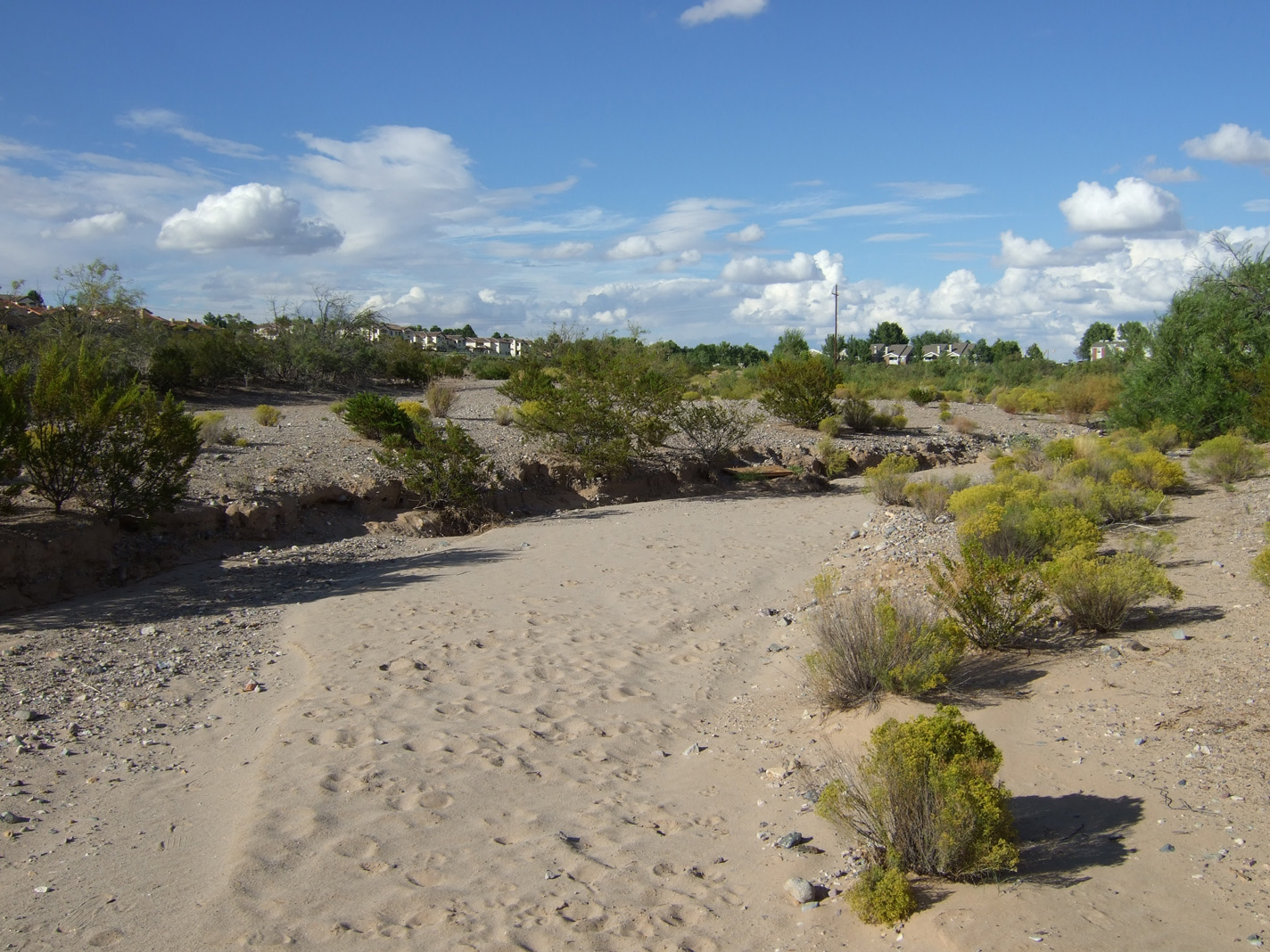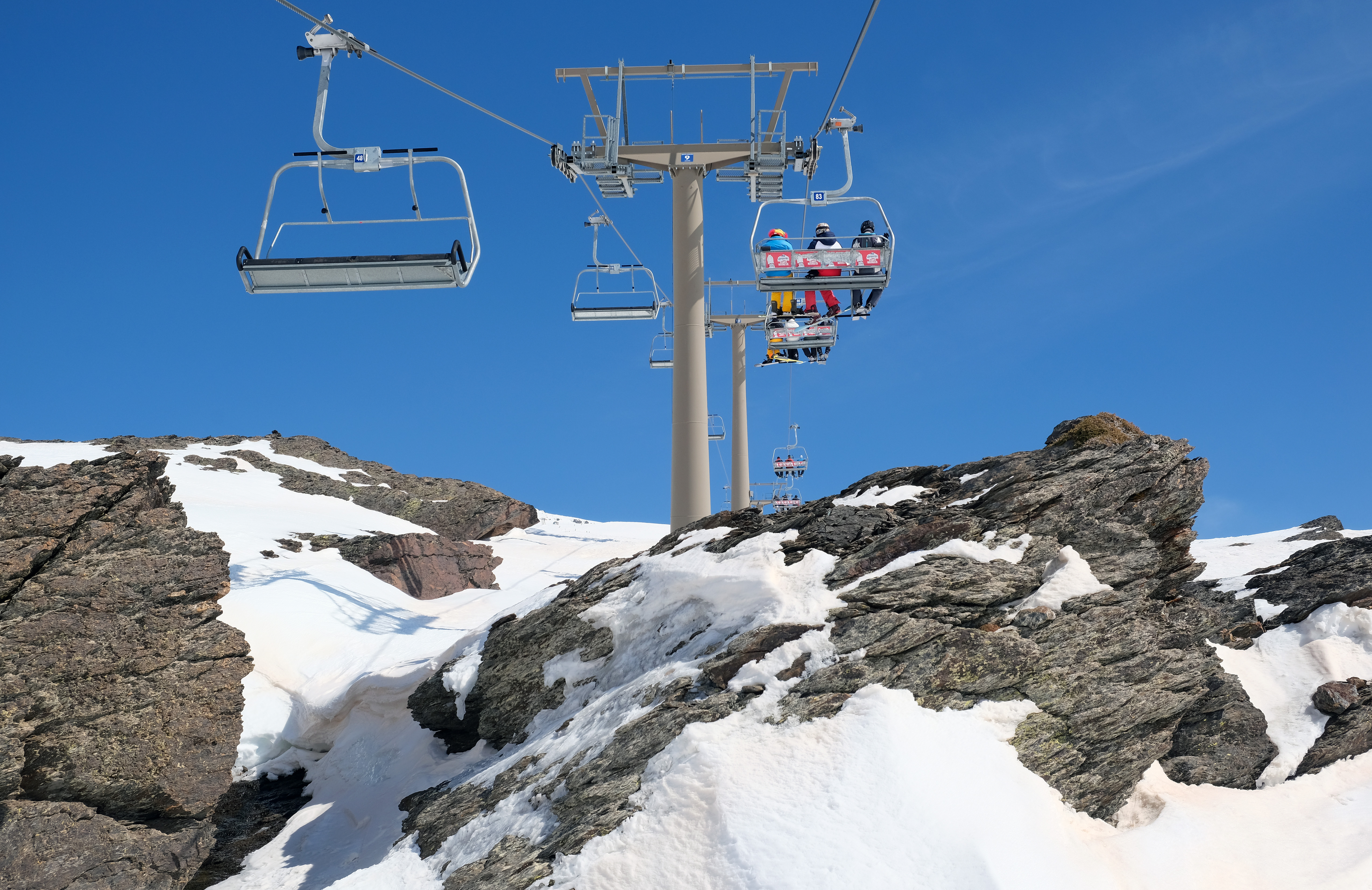|
Sandia Crest
Sandia Crest, also known locally as Sandia Peak or simply as the Crest, is a mountain ridge that, at , is the highpoint of the Sandia–Manzano Mountains, and is located in the Sandia Mountains of Bernalillo County, New Mexico, United States. Instead of a true summit or topographic peak, this range climbs to a long ridge line. To the east, the range slopes down from the Crest and merges into the plains below. On the west side of the Crest is a cliff; the range dramatically drops over in elevation over of horizontal distance to the Rio Grande Valley and city of Albuquerque below. It is within the Sandia Ranger District of the Cibola National Forest. The Crest features a viewing area with a shop and visitor center, telecommunications transmitters, the popular La Luz Trail, the Sandia Mountain Wilderness, and the summit of Sandia Peak Ski Area and the Sandia Peak Tramway, which is the longest aerial tramway in the Americas. Etymology Sandia Crest is named for its host range ... [...More Info...] [...Related Items...] OR: [Wikipedia] [Google] [Baidu] |
Arroyo (creek)
An arroyo ( (from Spanish ''arroyo'' (, "brook"))) or wash is a dry watercourse that temporarily or seasonally fills and flows after sufficient rain. Flash floods are common in arroyos following thunderstorms. It is akin to the Catalan rambla, which stems from the Arabic ''rámla'', "dry river". Similar landforms are referred to as '' wadi'' (in North Africa and Western Asia), ''chapp'' in the Gobi, ''laagate'' in the Kalahari, ''donga'' in South Africa, ''nullah'' in India, ''fiumare'' in Italy, and '' dry valley'' in England. The desert dry wash biome is restricted to the arroyos of the southwestern United States. Arroyos provide a water source to desert animals. Types and processes Arroyos can be natural fluvial landforms or constructed flood control channels. The term usually applies to a sloped or mountainous terrain in xeric and desert climates. In addition: in many rural communities arroyos are also the principal transportation routes; and in many urban communi ... [...More Info...] [...Related Items...] OR: [Wikipedia] [Google] [Baidu] |
Cibola National Forest
The Cibola National Forest (pronounced SEE-bo-lah) is a 1,633,783 acre (6,611.7 km2) United States National Forest in New Mexico, US. The name Cibola is thought to be the original Zuni Indian name for their pueblos or tribal lands. The name was later interpreted by the Spanish to mean "buffalo". The forest is disjointed with lands spread across central and northern New Mexico, west Texas and Oklahoma. The Cibola National Forest is divided into four Ranger Districts: the Sandia, Mountainair, Mt. Taylor, and Magdalena. The Forest includes the San Mateo, Magdalena, Datil, Bear, Gallina, Manzano, Sandia, Mt. Taylor, and Zuni Mountains of west-central New Mexico. The Forest also manages four National Grasslands that stretch from northeastern New Mexico eastward into the Texas Panhandle and western Oklahoma. The Cibola National Forest and Grassland is administered by Region 3 of the United States Forest Service from offices in Albuquerque, New Mexico. Elevation ranges from 5,0 ... [...More Info...] [...Related Items...] OR: [Wikipedia] [Google] [Baidu] |
Civilian Conservation Corps
The Civilian Conservation Corps (CCC) was a voluntary government unemployment, work relief program that ran from 1933 to 1942 in the United States for unemployed, unmarried men ages 18–25 and eventually expanded to ages 17–28. The CCC was a major part of President Franklin D. Roosevelt's New Deal that supplied manual labor jobs related to the conservation and development of natural resources in rural lands owned by federal, state, and local governments. The CCC was designed to supply jobs for young men and to relieve families who had difficulty finding jobs during the Great Depression in the United States. There was eventually a smaller counterpart program for unemployed women called the She-She-She Camps, which were championed by Eleanor Roosevelt. Robert Fechner was the first director of this agency, succeeded by James McEntee (labor leader), James McEntee following Fechner's death. The largest enrollment at any one time was 300,000. Through the course of its nine years ... [...More Info...] [...Related Items...] OR: [Wikipedia] [Google] [Baidu] |
Americas
The Americas, sometimes collectively called America, are a landmass comprising the totality of North America and South America.''Webster's New World College Dictionary'', 2010 by Wiley Publishing, Inc., Cleveland, Ohio. When viewed as a single continent, the Americas or America is the 2nd largest continent by area after Asia, and is the 3rd largest continent by population. The Americas make up most of the land in Earth's Western Hemisphere and comprise the New World. Along with their Lists of islands of the Americas, associated islands, the Americas cover 8% of Earth's total surface area and 28.4% of its land area. The topography is dominated by the American Cordillera, a long chain of mountains that runs the length of the west coast. The flatter eastern side of the Americas is dominated by large river basins, such as the Amazon basin, Amazon, St. Lawrence River–Great Lakes, Mississippi River System, Mississippi, and Río de la Plata Basin, La Plata basins. Since the Americ ... [...More Info...] [...Related Items...] OR: [Wikipedia] [Google] [Baidu] |
Tram To Sandia Peak, Albuquerque, New Mexico, USA
A tram (also known as a streetcar or trolley in Canada and the United States) is an urban rail transit in which vehicles, whether individual railcars or multiple-unit trains, run on tramway tracks on urban public streets; some include segments on segregated right-of-way. The tramlines or tram networks operated as public transport are called tramways or simply trams/streetcars. Because of their close similarities, trams are commonly included in the wider term ''light rail'', which also includes systems separated from other traffic. Tram vehicles are usually lighter and shorter than main line and rapid transit trains. Most trams use electrical power, usually fed by a pantograph sliding on an overhead line; older systems may use a trolley pole or a bow collector. In some cases, a contact shoe on a third rail is used. If necessary, they may have dual power systems—electricity in city streets and diesel in more rural environments. Occasionally, trams also carry freight. Some tr ... [...More Info...] [...Related Items...] OR: [Wikipedia] [Google] [Baidu] |
Chairlift
An elevated passenger ropeway, or chairlift, is a type of aerial lift, which consists of a continuously circulating steel wire rope loop strung between two end terminals and usually over intermediate towers. They are the primary on-hill transport at most ski areas (in such cases referred to as 'ski lifts'), but are also found at amusement parks and various tourist attractions. Depending on carrier size and loading efficiency, a passenger ropeway can move up to 4,000 people per hour, and the fastest lifts achieve operating speeds of up to or . The two-person double chair, which for many years was the workhorse of the ski industry, can move roughly 1,200 people per hour at rope speeds of up to . The four person detachable chairlift ("high-speed quad") can transport 2,400 people per hour with an average rope speed of . Some bi- and tri-cable elevated ropeways and reversible tramways achieve much greater operating speeds. Design and function A chairlift consists of numerous c ... [...More Info...] [...Related Items...] OR: [Wikipedia] [Google] [Baidu] |
New Mexico State Road 536
State Road 536 (NM 536) is a long state highway in the US state of New Mexico. NM 536's western terminus is a dead end at Sandia Crest and the eastern terminus is in San Antonito, Bernalillo County, New Mexico, San Antonito, at New Mexico State Road 14, NM 14. Major intersections See also * * References {{reflist State highways in New Mexico, 536 Transportation in Bernalillo County, New Mexico Transportation in Sandoval County, New Mexico ... [...More Info...] [...Related Items...] OR: [Wikipedia] [Google] [Baidu] |
Sandia Crest
Sandia Crest, also known locally as Sandia Peak or simply as the Crest, is a mountain ridge that, at , is the highpoint of the Sandia–Manzano Mountains, and is located in the Sandia Mountains of Bernalillo County, New Mexico, United States. Instead of a true summit or topographic peak, this range climbs to a long ridge line. To the east, the range slopes down from the Crest and merges into the plains below. On the west side of the Crest is a cliff; the range dramatically drops over in elevation over of horizontal distance to the Rio Grande Valley and city of Albuquerque below. It is within the Sandia Ranger District of the Cibola National Forest. The Crest features a viewing area with a shop and visitor center, telecommunications transmitters, the popular La Luz Trail, the Sandia Mountain Wilderness, and the summit of Sandia Peak Ski Area and the Sandia Peak Tramway, which is the longest aerial tramway in the Americas. Etymology Sandia Crest is named for its host range ... [...More Info...] [...Related Items...] OR: [Wikipedia] [Google] [Baidu] |
Cucurbita Foetidissima
is a genus of herbaceous fruits in the gourd family, Cucurbitaceae (also known as ''cucurbits'' or ''cucurbi''), native to the Andes and Mesoamerica. Five edible species are grown and consumed for their flesh and seeds. They are variously known as squash, pumpkin, or gourd, depending on species, variety, and local parlance. Other kinds of gourd, also called bottle-gourds, are native to Africa and belong to the genus '' Lagenaria'', which is in the same family and subfamily as ''Cucurbita'', but in a different tribe; their young fruits are eaten much like those of the ''Cucurbita'' species. Most ''Cucurbita'' species are herbaceous vines that grow several meters in length and have tendrils, but non-vining "bush" cultivars of ''C. pepo'' and ''C. maxima'' have also been developed. The yellow or orange flowers on a ''Cucurbita'' plant are of two types: female and male. The female flowers produce the fruit and the male flowers produce pollen. Many North and Cent ... [...More Info...] [...Related Items...] OR: [Wikipedia] [Google] [Baidu] |
Sandia Pueblo
Sandia Pueblo (; Tiwa: Tuf Shur Tia) is a federally recognized tribe of Native American Pueblo people inhabiting a reservation of the same name in the eastern Rio Grande Rift of central New Mexico. It is one of 19 of New Mexico's Native American pueblos, considered one of the state's Eastern Pueblos. The population was 427 as of the 2010 census. The people are traditionally Tiwa speakers, a language of the Tanoan group, although retention of the traditional language has waned with later generations. They have a tribal government that operates Sandia Casino, Bien Mur Indian Market Center, and Sandia Lakes Recreation Area, as well as representing the will of the Pueblo in business and political matters. Name The Tiwa name for the pueblo is ''Tuf Shur Tia'', or "Green Reed Place", in reference to the green ''bosque'' (). However, older documents claim that the original name of the pueblo was ''Nafiat'', (Tiwa: "Place Where the Wind Blows Dust"). It became known as ''Sandía ... [...More Info...] [...Related Items...] OR: [Wikipedia] [Google] [Baidu] |
Conifer
Conifers () are a group of conifer cone, cone-bearing Spermatophyte, seed plants, a subset of gymnosperms. Scientifically, they make up the phylum, division Pinophyta (), also known as Coniferophyta () or Coniferae. The division contains a single extant class (biology), class, Pinopsida. All Neontology, extant conifers are perennial plant, perennial woody plants with secondary growth. The majority are trees, though a few are shrubs. Examples include Cedrus, cedars, Pseudotsuga, Douglas-firs, Cupressaceae, cypresses, firs, junipers, Agathis, kauri, larches, pines, Tsuga, hemlocks, Sequoioideae, redwoods, spruces, and Taxaceae, yews.Campbell, Reece, "Phylum Coniferophyta". ''Biology''. 7th ed. 2005. Print. p. 595. As of 2002, Pinophyta contained seven families, 60 to 65 genera, and more than 600 living species. Although the total number of species is relatively small, conifers are ecology, ecologically important. They are the dominant plants over large areas of land, most notably ... [...More Info...] [...Related Items...] OR: [Wikipedia] [Google] [Baidu] |
Watermelon
The watermelon (''Citrullus lanatus'') is a species of flowering plant in the family Cucurbitaceae, that has a large, edible fruit. It is a Glossary of botanical terms#scandent, scrambling and trailing vine-like plant, and is plant breeding, widely cultivated worldwide, with more than 1,000 variety (botany), varieties. Watermelons are grown in favorable climates from tropics, tropical to temperate climate, temperate regions worldwide for its large edible fruit, which is a Berry (botany), berry with a hard rind and no internal divisions, and is botany, botanically called a Glossary of botanical terms#pepo, ''pepo''. The sweet, juicy flesh is usually deep red to pink, with many black seeds, although seedless fruit, seedless varieties exist. The fruit can be eaten raw or pickled, and the rind is edible after cooking. It may also be consumed as a juice or an ingredient in mixed beverages. Kordofan melons from Sudan are the closest relatives and may be progenitors of modern, cul ... [...More Info...] [...Related Items...] OR: [Wikipedia] [Google] [Baidu] |







